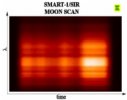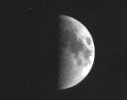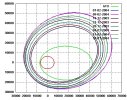SMART-1 Earth Bound
Over the next 13 months, the ion engine's cumulative thrust resulted in an outward spiralling orbit, continuously raising the perigee and apogee altitude, bringing the spacecraft ever closer to the first Lagrange point of the Earth-Moon system. After crossing this point, SMART-1 left its Earth bound orbit and entered lunar orbit. This page lists the key events during the Earth bound orbit.
29 September 2003 - Early commissioning of spacecraft
Status report: No. 1 - Initial Spacecraft Operations
30 September 2003 - First firing of ion engine
News: SMART-1 ion engine fired successfully
6 October 2003 - Ion engine fully tuned
Status Report: No. 2 - Early Ion Drive Performance
6 January 2004 - Spiralling out of radiation belts
Status Report: No. 14 - SMART-1 Escapes the Radiation Belts
February 2004 - Instrument commissioning, first images
From 30 January to 24 February 2004 the ion engine was inactive for a period of just over three weeks. The resulting stable platform conditions allowed the commissioning of the scientific instruments.
 |
 |
 |
|
SIR Moon scan |
AMIE image of Moon |
Spacecraft Orbits |
Status Report: No. 17 - Ion Engine Switched Off, Commissioning Begins
Status Report: No. 18 - Payload Commissioning
April 2004 - Insights from ion engine operations
A lot is learned from SMART-1's ion engine operations and performance in the vacuum of space. The gathered information provides new insights that are of great importance for any future mission that will use an electric propulsion system.
Status Report: No. 21 - SMART-1 as a Bench Test for Electric Propulsion
August-November 2004 - Lunar Resonances
Over the period mid August to mid November, SMART-1's orbit was altered at regular intervals (27.4 days) by a lunar resonance which occurred while SMART-1 was at apogee. This was in addition to the orbit boosts induced by the ongoing firings of the ion engine.
Status Report: No. 28 - First Lunar Resonance
Status Report: No. 29 - Second Lunar Resonance
Status Report: No. 30 - On Course for Lunar Capture
11 November 2004 - Crossing the first Lagrange point of the Earth-Moon system
On 11 November 2004 at 10:30 UTC, close to the 331st Earth apogee, SMART-1 was at the first Lagrange point of the Earth-Moon system, where the orbit is neither Earth, nor Moon bound. SMART-1 then crossed over to the region where the Moon's gravitational pull on the spacecraft is stronger than that of the Earth and was on its way to lunar capture.
Status report: No. 31 - SMART-1 from Earth-bound to Moon-bound
